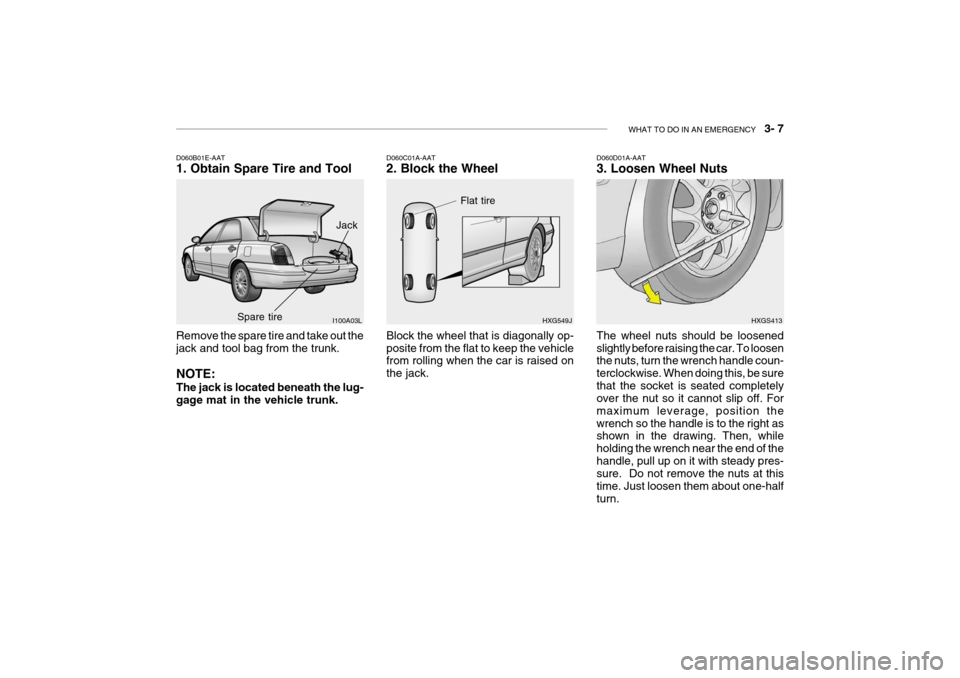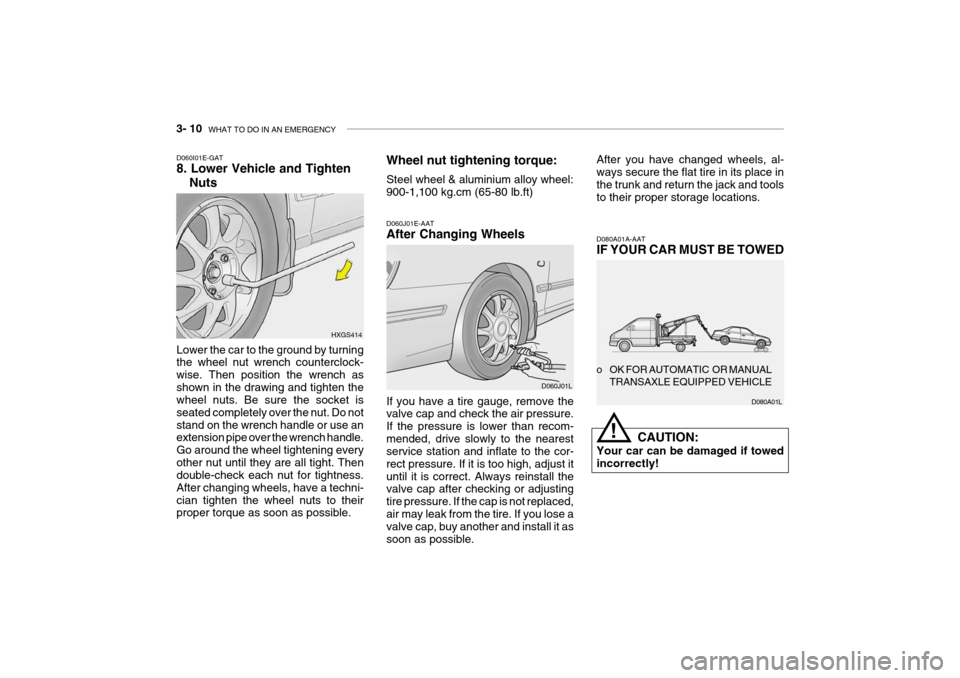2004 Hyundai Grandeur run flat
[x] Cancel search: run flatPage 52 of 235

FEATURES OF YOUR HYUNDAI 1- 39
o Do not tamper with or discon-
nect SRS wiring, or other com- ponents of the SRS system. Do-ing so could result in injury, due to accidental firing of the airbags or by rendering the SRS inopera-tive.
o If components of the airbag sys-
tem must be discarded, or if thevehicle must be scrapped, cer- tain safety precautions must be observed. Your Hyundai dealerknows these precautions and can give you the necessary informa- tion. Failure to follow these pre-cautions and procedures could increase the risk of personal in- jury.
o If you sell your vehicle, make certain that this manual is trans-ferred to the new owner.
o If your car was flooded and has soaked carpeting or water onflooring, you shouldn't try to startengine; have the car towed to authorized Hyundai dealer.B240D01JM-AAT Additional Safety Precautions oNever let passengers ride in the cargo area (trunk) or on top of a folded-down back seat. All occu-
pants should sit upright, fully back in their seats with their seat belts on and their feet on the floor.
o Passengers should not move out of or change seats while the ve- hicle is moving. A passenger who
is not wearing a seat belt during a crash or emergency stop can be thrown against the inside of thevehicle, against other occupants, or out of the vehicle.
o Each seat belt is designed to restrain one occupant. If more
than one person uses the sameseat belt, they could be seriouslyinjured or killed in a collision.
o Do not use any accessories onseat belts. Devices claiming to im-
prove occupant comfort or reposi- tion the seat belt can reduce the protection provided by the seat beltand increase the chance of serious injury in a crash. o
Passengers should not placehard or sharp objects between themselves and the airbags. Car-
rying hard or sharp objects on your lap or in your mouth can result in injuries if an airbag inflates.
o Keep occupants away from the airbag covers. All occupants should
sit upright, fully back in their seats with their seat belts on and their feet on the floor. If occupants are too close to the airbag covers, theycould be injured if the airbags in- flate.
o Do not attach or place objects onor near the airbag covers. Any
object attached to or placed on the front or side impact airbag covers could interfere with the proper op- eration of the airbags.
o Do not modify the front seats. Modification of the front seats could interfere with the operation of thesupplemental restraint system sens- ing components or side impact airbags.
Page 148 of 235

DRIVING YOUR HYUNDAI 2- 15
o Don't "ride" the brake or clutch pedal.
This can increase fuel consumption and also increase wear on thesecomponents. In addition, driving with your foot resting on the brake pedal may cause the brakes to overheat,which reduces their effectiveness and may lead to more serious con- sequences.
o Take care of your tires. Keep them inflated to the recommended pres-sure. Incorrect inflation, either toomuch or too little, results in unnec- essary tire wear. Check the tire pres- sures at least once a month.
o Be sure that the wheels are aligned correctly. Improper alignment canresult from hitting curbs or drivingtoo fast over irregular surfaces. Poor alignment causes faster tire wear and may also result in other prob-lems as well as greater fuel con- sumption.
o Keep your car in good condition. For better fuel economy and reducedmaintenance costs, maintain your car in accordance with the mainte-nance schedule in Section 5. If you drive your car in severe conditions, more frequent maintenance is re-quired (see Section 5 for details). o Keep your car clean. For maximum
service, your Hyundai should bekept clean and free of corrosivematerials. It is especially important that mud, dirt, ice, etc. not be al- lowed to accumulate on the under-side of the car. This extra weight can result in increased fuel con- sumption and also contribute to cor-rosion.
o Travel lightly. Don't carry unneces-
sary weight in your car. Weight re-duces fuel economy.
o Don't let the engine idle longer than
necessary. If you are waiting (andnot in traffic), turn off your engine and restart only when you're ready to go.
o Remember, your Hyundai does not require extended warm-up. As soonas the engine is running smoothly,you can drive away. In very cold weather, however, give your engine a slightly longer warm-up period.
C140A01A-AAT DRIVING FOR ECONOMY You can save fuel and get more miles from your car if you follow these sug-gestions:
o Drive smoothly. Accelerate at a
moderate rate. Don't make "jack- rabbit" starts or full-throttle shifts and maintain a steady cruisingspeed. Don't race between stop- lights. Try to adjust your speed to that of the other traffic so you don'thave to change speeds unneces- sarily. Avoid heavy traffic whenever possible. Always maintain a safedistance from other vehicles so you can avoid unnecessary braking. This also reduces brake wear.
o Drive at a moderate speed. The faster you drive, the more fuel yourcar uses. Driving at a moderatespeed, especially on the highway, is one of the most effective ways to reduce fuel consumption.
Page 162 of 235

WHAT TO DO IN AN EMERGENCY 3- 7
Remove the spare tire and take out the jack and tool bag from the trunk. NOTE: The jack is located beneath the lug- gage mat in the vehicle trunk.
D060B01E-AAT 1. Obtain Spare Tire and Tool
I100A03L
D060C01A-AAT 2. Block the Wheel Block the wheel that is diagonally op- posite from the flat to keep the vehicle from rolling when the car is raised on the jack.HXG549JD060D01A-AAT 3. Loosen Wheel Nuts
HXGS413
The wheel nuts should be loosened slightly before raising the car. To loosen the nuts, turn the wrench handle coun- terclockwise. When doing this, be surethat the socket is seated completely over the nut so it cannot slip off. For maximum leverage, position thewrench so the handle is to the right as shown in the drawing. Then, while holding the wrench near the end of thehandle, pull up on it with steady pres- sure. Do not remove the nuts at this time. Just loosen them about one-halfturn.
Jack
Spare tire
Flat tire
Page 165 of 235

3- 10 WHAT TO DO IN AN EMERGENCY
Lower the car to the ground by turning the wheel nut wrench counterclock- wise. Then position the wrench asshown in the drawing and tighten the wheel nuts. Be sure the socket is seated completely over the nut. Do not
stand on the wrench handle or use an extension pipe over the wrench handle. Go around the wheel tightening everyother nut until they are all tight. Then double-check each nut for tightness. After changing wheels, have a techni-cian tighten the wheel nuts to their proper torque as soon as possible.
D060I01E-GAT 8. Lower Vehicle and Tighten
Nuts
HXGS414Wheel nut tightening torque: Steel wheel & aluminium alloy wheel: 900-1,100 kg.cm (65-80 lb.ft)
D060J01E-AAT After Changing Wheels If you have a tire gauge, remove the valve cap and check the air pressure. If the pressure is lower than recom-mended, drive slowly to the nearest service station and inflate to the cor- rect pressure. If it is too high, adjust ituntil it is correct. Always reinstall the valve cap after checking or adjusting tire pressure. If the cap is not replaced,air may leak from the tire. If you lose a valve cap, buy another and install it as soon as possible.
D060J01LAfter you have changed wheels, al- ways secure the flat tire in its place in the trunk and return the jack and toolsto their proper storage locations.
D080A01A-AAT IF YOUR CAR MUST BE TOWED
CAUTION:
Your car can be damaged if towed incorrectly!
o OK FOR AUTOMATIC OR MANUAL
TRANSAXLE EQUIPPED VEHICLE
D080A01L
!
Page 234 of 235

INDEX 10- 5
Adjusting seat forwar d and rearward..................... 1-14
Adjusting seatback angle ................. ...................... 1-15
Seat cushion height adjustment............................ 1-15
Power Steering Fluid Level ............................. ..........6-24
R
Rear Seat Fold Down ............................................. 1-18 Rear Window Defroster Switch .................... 1-54 ~ 1-55
Replacement of light bulbs .......................................6-26
SSeat Front ........................................................... 1-11 ~ 1-15
Seat Warmer ............................................................. 1-17
Seat Belts 3-Point system ........................................... 1-21 ~ 1-23
Adjustable height ........................................ 1-21 ~ 1-22 Adjusting your seat be lt .........................................1-22
Care of seat belts .................................................. 1-20
Precautions ............................................................ 1-19
Spark Plugs ................................................... 6-10 ~ 6-11
Spectacle Case ......................................................... 1-63
Speedometer ............................................................. 1-47
Starting Procedure ...................................................... 2-4
Steering Wheel Freeplay .................. ........................ 6-19
Steering Wheel Electric T ilt and Telescopic ............. 1-75
Steering Wheel Tilt Lever .............. ...........................1-73
Stereo Radio Operation (H940B, H940A)
......................................... 1-97 ~ 1-99, 1-105 ~ 1-107
Stereo Sound System ................................... 1-95 ~ 1-96 Sun Visor
.................................................................. 1-73
Sunroof .......................................................... 1-59 ~ 1-61
T Tachometer ............................................................... 1-48
Theft-Alarm system ........................................... 1-8 ~ 1-9Tires Balancing .................................................................. 8-4
Chains ...................................................................... 8-4
If you have a flat ti re ................................... 3-5 ~ 3-10
Information ............................................................... 8-2
Pressure ......................................................... 8-2 ~ 8-3
Replacement ............................................................ 8-5
Rotation .................................................................... 8-4
Snow tires ................................................................ 8-3
Spare tire ................................................................. 3-5
Traction .................................................................... 8-4
Towing
A trailer (or vehicle) ................................... 2-18 ~ 2-21
Emergency ............................................................. 3-12
If your car must be towed ......................... 3-10 ~ 3-12
Traction Control System ............................... 2-12 ~ 2-13
Transaxle Automatic ..................................................... 2-7 ~ 2-11Automatic transaxle fluid checking ............ 6-14 ~ 6-15
Manual ..................................................................... 2-5
Manual transaxle Oil che cking ................... 6-13 ~ 6-14
Trip Computer ............................................... 1-55 ~ 1-56
Trip Odometer ............................................... 1-48 ~ 1-49
Trunk Lid ....................................................... 1-66 ~ 1-68